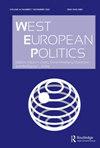多党制中基于群体的舆论两极分化
IF 3.6
1区 社会学
Q1 POLITICAL SCIENCE
引用次数: 3
摘要
舆论两极分化会损害社会在不同政治问题领域达成民主共识的能力。当观点的两极分化与明确可识别的社会群体相吻合时,这一点尤其明显。有关舆论两极化的文献大多集中在美国的两党制背景下。我们缺乏能够适用于具有多党制和多层群体特征的欧洲国家的概念和措施。这篇文章提出了社会群体之间两极分化的概念。它提供了一种衡量方法,可以捕捉到不同群体之间意识形态分布的重叠。两步经验框架包括层次IRT模型和分布不相似性的度量。第二部分基于瑞士(1994-2016)的调查数据提出了该措施的实证应用,揭示了政党支持者和教育团体之间民意两极分化的深刻动态。本文章由计算机程序翻译,如有差异,请以英文原文为准。
Group-based public opinion polarisation in multi-party systems
Abstract Public opinion polarisation can impair society’s ability to reach a democratic consensus in different political issue areas. This appears particularly true when the polarisation of opinions coincides with clearly identifiable social groups. The literature on public opinion polarisation has mostly focussed on the US two-party context. We lack concepts and measures that can be adapted to European countries with multi-party systems and multi-layered group identities. This article proposes a conceptualisation of polarisation between groups in society. It presents a measure that captures the overlap of ideology distributions between groups. The two-step empirical framework includes hierarchical IRT models and a measure for dissimilarity of distributions. The second part presents an empirical application of the measure based on survey data from Switzerland (1994–2016), which reveals insightful dynamics of public opinion polarisation between party supporters and education groups.
求助全文
通过发布文献求助,成功后即可免费获取论文全文。
去求助
来源期刊

West European Politics
POLITICAL SCIENCE-
CiteScore
10.00
自引率
7.10%
发文量
58
期刊介绍:
West European Politics (WEP)has established itself as one of the most authoritative journals covering political and social issues in Western Europe. It has a substantial reviews section and coverage of all national elections in Western Europe. Its comprehensive scope, embracing all the major political and social developments in all West European countries, including the European Union, makes it essential reading for both political practitioners and academics.
 求助内容:
求助内容: 应助结果提醒方式:
应助结果提醒方式:


